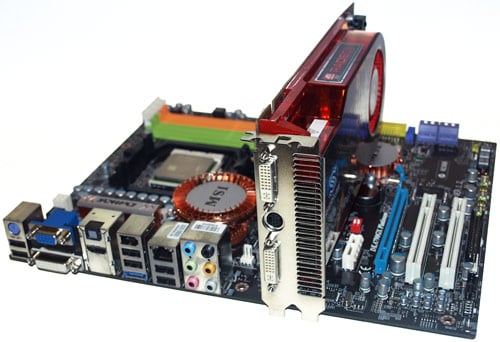Enter The Dragon: AMD Phenom II X4 940
Introduction and Specifications

 AMD has been fighting an uphill battle on two fronts for the last few years. For a time, fierce competition from NVIDIA, coupled with some of their own problems executing, put the ATI graphics division in a deep hole. And ever since the introduction of the original Core 2 processors, and more recently the Core i7, AMD's processor division has fallen well behind Intel in terms of overall performance.
AMD has been fighting an uphill battle on two fronts for the last few years. For a time, fierce competition from NVIDIA, coupled with some of their own problems executing, put the ATI graphics division in a deep hole. And ever since the introduction of the original Core 2 processors, and more recently the Core i7, AMD's processor division has fallen well behind Intel in terms of overall performance.
Starting in November of 2007 though, we got a sense that AMD was slowly, but surely, clawing its way back into the fight. It began with the introduction of the Spider platform, which consisted of AMD's native quad-core Phenom processors, 7-series chipsets, and 3800-series graphics cards. Individually, the components that made up the Spider platform weren't performance leaders in their respective categories, but ultimately the platform proved to be solid, and of course, it was priced very competitively. The introduction of Spider also marked the first time AMD could offer an entire desktop platform consisting only of AMD-branded processors, core logic, and graphics.
As many of you know, AMD hasn't been sitting idle since the Spider platform introduction. The company's chipset division has launched a handful of new chipsets, featuring one of--if not--the best IGPs on the market and a new Southbridge, the SB750, that allows for higher overclocks through the use of ACC, or Advanced Clock Calibration. The ATI graphics division has also been firing on all cylinders lately, having released a top to bottom lineup of GPUs that compete very favorably at their respective price points. AMD also recaptured the 3D performance crown from NVIDIA for a time with the Radeon HD 4870 X2. AMD wasn't going down without a fight.
With the chipset and graphics divisions on a roll, it was time for the CPU team to pull the trigger on something new and exciting, to complete the new platform trifecta. It took some time, but that's exactly what's happening today. The end result is the Dragon platform which consists of new 45nm Phenom II X4 processors, 7-series chipsets, and ATI Radeon 4000 series graphics cards. We've got the goods in house and will fill you in on all of the juicy details on the pages ahead; for now let's get some of the particulars and back-story out of the way...

AMD Dragon Platform
|
| Model / Processor Frequency: | AMD Phenom II Processor Model X4 940 / X4 920 / 3.0GHz, 2.8GHz |
| L1 Cache Sizes: | 64K of L1 instruction and 64K of L1 data cache per core (512KB total L1 per processor) |
| L2 Cache Sizes: | 512KB of L2 data cache per core (2MB total L2 per processor) |
| L3 Cache Size: | 6MB (shared) |
| Memory Controller Type: | Integrated 128-bit wide memory controller, capable of being configured for dual 64-bit channels for simultaneous read/writes |
| Memory Controller Frequency: | Up to 1.8GHz with Dual Dynamic Power Management |
| Types of Memory: | Support for unregistered DIMMs up to PC2 8500 (DDR2-1066MHz) |
| HyperTransport 3.0: | One 16-bit/16-bit link @ up to 3600MHz full duplex |
| Total Processor Bandwidth: | Up to 31.5 GB/s bandwidth |
| Packaging: | Socket AM2+ 940-pin organic micro pin grid array (micro-PGA) (backward compatible with Socket AM2) |
| Fab location: | AMD's Fab 36 wafer fabrication facilities in Dresden, Germany |
| Process Technology: | 45nm (.045-micron) DSL Silicon on Insulator (SOI) |
| Approximate Transistor count: | approx. ~758 million (65nm) |
| Approximate Die Size: | 258 mm2 (45nm) |
| Nominal Voltage: | .0875-1.5 Volts |
| Max Ambient Case Temp: | 62 degress Celsius |
| Max TDP: | 125 Watts |
| ACP: | *to be announced after launch |
| Future Memory Controller Note: | Future 45nm processors versions are planned to include support for DDR3 memory |
 Although the Dragon platform as a whole is new, most of its parts have already been on the scene for quite some time now. As such, we have already covered them in-depth here on HotHardware, so we won't do the same again here. We will, however, recommend taking a look at a few past articles to get familiar with some of the underlying technology and components that partially comprise the Dragon platform.
Although the Dragon platform as a whole is new, most of its parts have already been on the scene for quite some time now. As such, we have already covered them in-depth here on HotHardware, so we won't do the same again here. We will, however, recommend taking a look at a few past articles to get familiar with some of the underlying technology and components that partially comprise the Dragon platform.- ATI Radeon HD 4850 and 4870: RV770 Has Arrived
- ATI Radeon HD 4870 X2 - AMD Back On Top
- AMD 790GX Chipset Platform Launch
- AMD 780G Chipset and Athlon X2 4850e Preview
- AMD Phenom X4 9350e and 9950 BE Debut
- AMD Spider Platform - Phenom, 790FX, RV670
The Radeon HD 4800 series articles detail the features and technology that have made them so successful in the 3D graphics space. And the various 7-series chipset, Phenom and Athlon processor, and Spider platform related articles cover the remainder of the platform--with the exception of the Phenom II that is, which we'll show you next.






